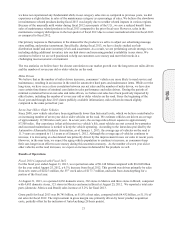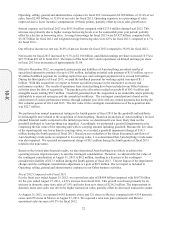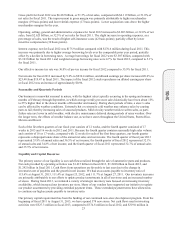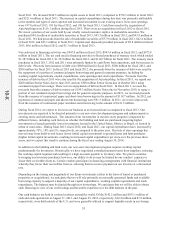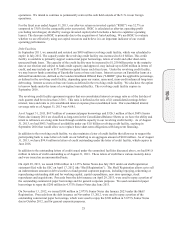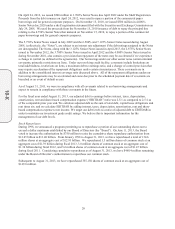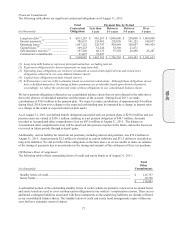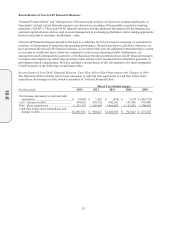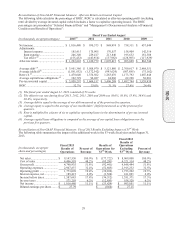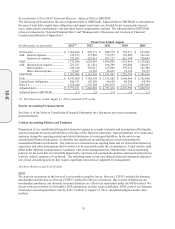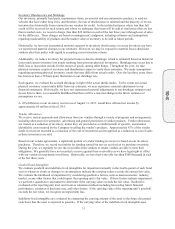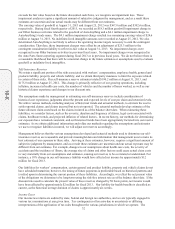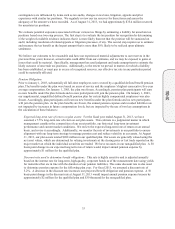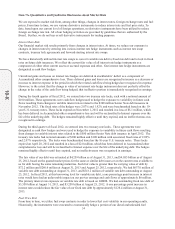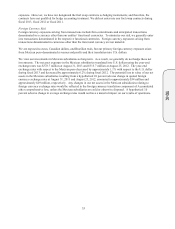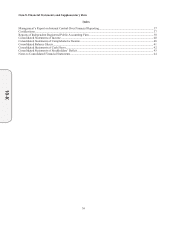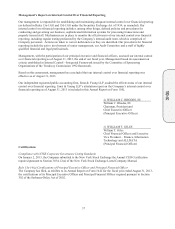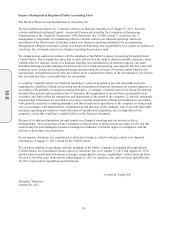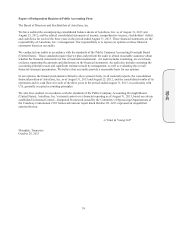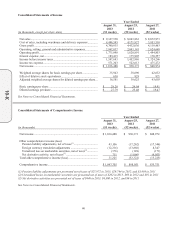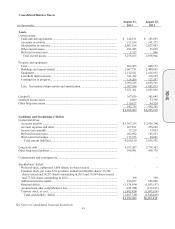AutoZone 2013 Annual Report Download - page 93
Download and view the complete annual report
Please find page 93 of the 2013 AutoZone annual report below. You can navigate through the pages in the report by either clicking on the pages listed below, or by using the keyword search tool below to find specific information within the annual report.
31
Inventory Obsolescence and Shrinkage
Our inventory, primarily hard parts, maintenance items, accessories and non-automotive products, is used on
vehicles that have rather long lives; and therefore, the risk of obsolescence is minimal and the majority of excess
inventory has historically been returned to our vendors for credit. In the isolated instances where less than full
credit will be received for such returns and where we anticipate that items will be sold at retail prices that are less
than recorded costs, we record a charge (less than $20 million in each of the last three years) through cost of sales
for the difference. These charges are based on management’s judgment, including estimates and assumptions
regarding marketability of products and the market value of inventory to be sold in future periods.
Historically, we have not encountered material exposure to inventory obsolescence or excess inventory, nor have
we experienced material changes to our estimates. However, we may be exposed to material losses should our
vendors alter their policy with regard to accepting excess inventory returns.
Additionally, we reduce inventory for projected losses related to shrinkage, which is estimated based on historical
losses and current inventory loss trends resulting from previous physical inventories. Shrinkage may occur due to
theft, loss or inaccurate records for the receipt of goods, among other things. Throughout the year, we take
physical inventory counts of our stores and distribution centers to verify these estimates. We make assumptions
regarding upcoming physical inventory counts that may differ from actual results. Over the last three years, there
has been less than a 50 basis point fluctuation in our shrinkage rate.
Each quarter, we evaluate the accrued shrinkage in light of the actual shrink results. To the extent our actual
physical inventory count results differ from our estimates, we may experience material adjustments to our
financial statements. Historically, we have not experienced material adjustments to our shrinkage estimates and
do not believe there is a reasonable likelihood that there will be a material change in the future estimates or
assumptions we use.
A 10% difference in our inventory reserves as of August 31, 2013, would have affected net income by
approximately $6 million in fiscal 2013.
Vendor Allowances
We receive various payments and allowances from our vendors through a variety of programs and arrangements,
including allowances for warranties, advertising and general promotion of vendor products. Vendor allowances
are treated as a reduction of inventory, unless they are provided as a reimbursement of specific, incremental,
identifiable costs incurred by the Company in selling the vendor’s products. Approximately 87% of the vendor
funds received are recorded as a reduction of the cost of inventories and recognized as a reduction to cost of sales
as these inventories are sold.
Based on our vendor agreements, a significant portion of vendor funding we receive is based on our inventory
purchases. Therefore, we record receivables for funding earned but not yet received as we purchase inventory.
During the year, we regularly review the receivables from vendors to ensure vendors are able to meet their
obligations. We generally have not recorded a reserve against these receivables as we have legal right of offset
with our vendors for payments owed them. Historically, we have had write-offs less than $500 thousand in each
of the last three years.
Goodwill and Intangibles
We evaluate goodwill and indefinite-lived intangibles for impairment annually in the fourth quarter of each fiscal
year or whenever events or changes in circumstances indicate the carrying values exceeds the current fair value.
We evaluate the likelihood of impairment by considering qualitative factors, such as macroeconomic, industry,
market, or any other factors that could impact the reporting unit’s fair value. If these factors indicate impairment,
we perform a quantitative assessment to determine if the carrying value exceeds the fair value. Goodwill is
evaluated at the reporting unit level and involves valuation methods including forecasting future financial
performance, estimates of discount rates, and other factors. If the carrying value of the reporting unit’s goodwill
exceeds the fair value, we recognize an impairment loss.
Indefinite-lived intangibles are evaluated by comparing the carrying amount of the asset to the future discounted
cash flows that the asset is expected to generate. If the carrying value of the indefinite-lived intangible asset
10-K


